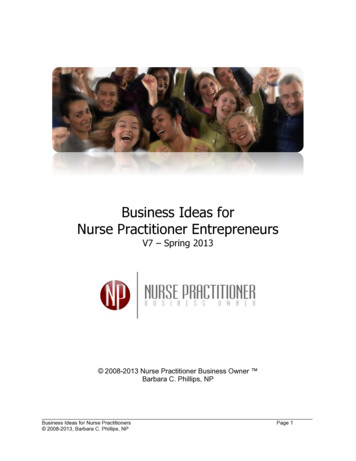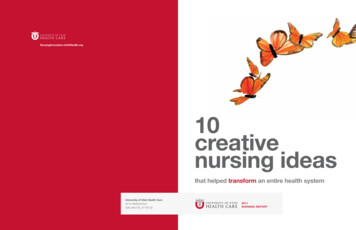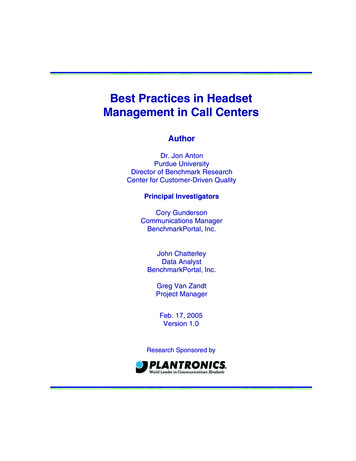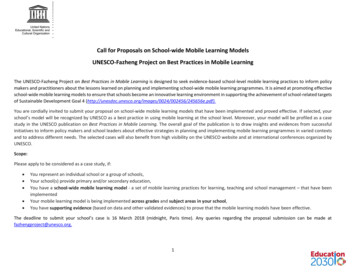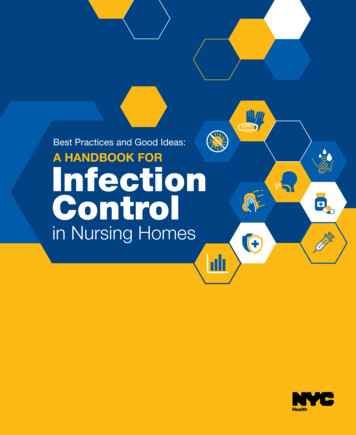
Transcription
Best Practices and Good Ideas:A HANDBOOK FORInfectionControlin Nursing Homes
Contributors:Mary Foote, MD, MPHPamela Kellner, RN, MPHChristian Oriuwa, MBBS, MSc.Gloria Airall-Simon, PhD, MPHE, MSN, BSNThis publication was supported by the Epidemiology and Laboratory Capacity (ELC) for InfectiousDiseases Cooperative Agreement (Grant Number: 6 NU50CK000407-01-07) from the Centers forDisease Control and Prevention (CDC). Its contents are solely the responsibility of the authors anddo not necessarily represent the official views of the CDC or the New York City Department of Healthand Mental Hygiene.AcknowledgmentsThe New York City Department of Health and Mental Hygiene developed the Best Practices andGood Ideas Handbook for Infection Control in Nursing Homes as an infection control resourcefor nursing home staff at all levels and in every discipline.This guide would not be possible without the many dedicated New York City (NYC) nursing homestaff who participated in the Health Department and the Centers for Disease Control and Prevention’s(CDC) national Infection Control Assessment and Response (ICAR) program.Participating nursing homes in NYC welcomed the Health Department team and gave the themaccess to the people, processes and environments involved in infection control practices. Participantsshared their knowledge and innovations with us and we present them here so that all nursing homescan benefit.
In This Handbook:Introduction . . . . . . . . . . . . . . . . . . . . 1How to Use This Handbook . . . . . . . . 2Respiratory Hygieneand Cough Etiquette . . . . . . . . . . . . 39Useful Definitions . . . . . . . . . . . . . . . . 3Best Practices Recommendations . . 39Good Ideas! . . . . . . . . . . . . . . . . . . . 40Infection Control Program . . . . . . . . 7Additional Resources . . . . . . . . . . . . 41Best Practices Recommendations . . . 7Good Ideas! . . . . . . . . . . . . . . . . . . . . 9Antibiotic Stewardship . . . . . . . . . . 45Additional Resources . . . . . . . . . . . . 11Best Practices Recommendations . . 45Good Ideas! . . . . . . . . . . . . . . . . . . . 47Health Care Personneland Resident Safety . . . . . . . . . . . . 15Additional Resources . . . . . . . . . . . . 48Best Practices Recommendations . . 15Good Ideas! . . . . . . . . . . . . . . . . . . . 17Injection Safety andPoint of Care Testing . . . . . . . . . . . . 53Additional Resources . . . . . . . . . . . . 18Best Practices Recommendations . . 53Good Ideas! . . . . . . . . . . . . . . . . . . . 54Surveillance andDisease Reporting . . . . . . . . . . . . . . 21Additional Resources . . . . . . . . . . . . 55Best Practices Recommendations . . 21Good Ideas! . . . . . . . . . . . . . . . . . . . 23Environmental Cleaningand Disinfection . . . . . . . . . . . . . . . . 59Additional Resources . . . . . . . . . . . . 24Best Practices Recommendations . . 59Good Ideas! . . . . . . . . . . . . . . . . . . . 60Hand Hygiene . . . . . . . . . . . . . . . . . . 27Additional Resources . . . . . . . . . . . . 61Best Practices Recommendations . . 27Good Ideas! . . . . . . . . . . . . . . . . . . . 28Appendix A . . . . . . . . . . . . . . . . . . . . 65Additional Resources . . . . . . . . . . . . 29 Assessing Health Care PersonnelProtection Prevention Practices:Links to ResourcesPersonal ProtectiveEquipment (PPE) . . . . . . . . . . . . . . . 33Best Practices Recommendations . . 33Good Ideas! . . . . . . . . . . . . . . . . . . . 35Additional Resources . . . . . . . . . . . . 36Appendix B . . . . . . . . . . . . . . . . . . . . 69Stop Infection at the DoorAppendix C . . . . . . . . . . . . . . . . . . . . 70 Candida auris: A drug-resistant yeastthat spreads in healthcare facilities
Introductionintro.The New York City Department of Health and Mental Hygiene (DOHMH)developed this guide for new infection preventionists and other nursing homestaff. Nursing homes (i.e., long-term care facilities) are critical settings forinfection control and prevention. Nursing home residents are often physicallyfrail with faltering immune systems. They are exposed to microbes (“germs”)carried into the nursing home by staff, volunteers, clergy, family members,visitors and fellow residents. As a result, health care-associated infections(HAI) are responsible for at least 380,000 deaths among nursing homeresidentseveryyear.1 The risksRecommendationsto older adults exist outside of nursing homesBestPracticeas well. For example, when transferred to acute care facilities, nursing homeresidents are at risk for acquiring and transmitting infections both withinthe acute care facility and upon return to the nursing home. Additionally,providers may not prescribe antibiotics to nursing home residents accordingto recommended guidelines, increasing the possibility that those residentswill contract certain infections such as C. difficile, or will develop an antibioticresistant infection in the future.2The Infection Control Assessmentand Response Program (ICAR)The Centers for Disease Control and Prevention (CDC) developed the ICAR program in 2014in response to lessons learned during the Ebola crisis. ICAR is an emergency preparednessprogram that helps health care facilities assess infection control practices and identifyopportunities for improvement. State and local health department teams visited ICAR programsites from 2015 through 2017. Teams included physicians, nurses and other public health andinfection-control specialists.Clinical facilities at all levels (hospitals, clinics, urgent care centers and long-term caresettings including nursing homes) were recruited by the Health Department’s ICAR team tovoluntarily participate in the program. Nursing home staff used standardized CDC surveyforms3 and worked with state and local health department teams to self-evaluate their1U.S. Department of Health and Human Services. National Action Plan to Prevent Health Care-Associated Infections: Road Map to Elimination.Chapter 8, Long-Term Care Facilities. April 2013. f. Accessed July 3, 2018.2Nicolle LE, Strausbaugh LJ, Garibaldi RA. Infections and antibiotic resistance in nursing homes. Clin Microbiol Rev. 1996 Jan;9(1):1-17.PMID: 8665472; /pdf/090001.pdf3CDC Infection Control Assessment Tools at assessment-tools.html1
infection control practices, successes and challenges. Participating nursing homes receivedsite-specific recommendations and resources from the site visit teams. The recommendationcategories provided below are based on the key infection control domains outlined in the CDCassessment tool: Infection Control Program and Infrastructure Health Care Personnel and Resident Safety Surveillance and Disease Reporting Hand Hygiene Personal Protective Equipment (PPE) Respiratory/Cough Etiquette Antibiotic Stewardship Injection Safety and Point of Care Testing Environmental CleaningICAR in New York CityBetween 2016 and 2017, the New York City Department of Health and Mental Hygiene recruited73 nursing homes to participate in the ICAR program (43 percent of all NYC nursing homes).Key nursing home staff—including infection preventionists (IP), clinicians, administrators andenvironmental services staff—participated in the site visits. These staff members gave generouslyof their time, investing significant effort in completing the initial assessment survey, meetingwith the Health Department team, establishing improvement goals and completing follow-upassessments to report on their progress.For more information on the ICAR program, visit cdc.gov and search for “HAI Infection ControlAssessment Tools.”How to Use This HandbookInfection preventionists and other nursing home staff can use this handbook as a quick reviewof CDC-recommended best practices for infection control in nursing homes. This handbook alsoincludes creative approaches to getting things done that come directly from our nursing homecolleagues. Provide copies of this handbook to staff in all departments, from the front desk to thebedside and beyond.2
Useful DefinitionsHealth Care PersonnelInfection Prevention(IP) Competency:The proven ability to apply essential knowledge, skills andabilities to prevent the transmission of pathogens during theprovision of care.Health Care PersonnelIP Competency-BasedTraining:The provision of job-specific education, training and assessmentto ensure that health care personnel possess IP competency.CompetencyAssessment:The verification of IP competency through the use of knowledgebased testing and direct observation. If direct observation is notincluded as part of a competency assessment, an alternativemethod to ensure that health care personnel possess essentialknowledge, skills and abilities should be used.Audit:Direct observation or monitoring of health care personneladherence to job-specific IP measures.Feedback:A summary of audit findings that is used to target performanceimprovement.3
InfectionControl ProgramInfectionControl Program
Infection ControlProgramInfection control programs monitor, prevent and stop the spread of infectionsin health care settings.In nursing homes, infection control best practices require a dedicated, trainedand, ideally, certified infection preventionist (IP) to manage the infection controlprogram. This person is responsible for implementing and/or coordinatinginfection control activities, including: Disease surveillance Implementingisolation precautionsBest PracticeRecommendations Investigating and controlling outbreaks Disease reporting and coordinating with the health department Resident care Employee health measuresBest Practice Recommendations Receive specialized training in infection prevention and control. Beginning inNovember 2019, the Centers for Medicare and Medicaid Services (CMS) will require allnursing homes to have a designated IP with specialized training in infection preventionand control.4 Examples of training may include:—Successful—completion of initial and/or recertification exams developed by the CertificationBoard for Infection Control & Epidemiology—Participation—in infection control courses organized by the CDC, the state or recognizedprofessional societies Oversee the full range of infection control activities in a facility. These activities include:—Conducting—ongoing disease surveillance—Maintaining—ongoing awareness of infections in the facility—Monitoring—the usage and evaluating the efficacy of infection control measures—Maintaining—and updating policy and procedure manuals and making content accessibleto staff4CMS Medicare and Medicaid Programs Reform of Requirements for Long-Term Care Facilities. ing-Homes.html7
—Training—staff on infection prevention Coordinate infection control activities directly with state and local health authorities,particularly in the event of an outbreak in the facility. Participate in pertinent trainings and emergency preparedness activities. Participate in your facility’s quality assessment and assurance committee, andsupport antibiotic stewardship efforts.Beginning in November 2019, all long-term care facilities must also integrate infectionprevention and control programs with quality assurance and improvement activities.5The following are potential quality assurance and improvement activities: Ensure residents are educated on and offered influenza and pneumococcal vaccine(s). Ensure staff are offered influenza vaccines. Monitor rates of infections. Track antibiotic usage rates. Provide robust trainings and competency evaluations for staff. Organize regular and standardized audits.58CMS Medicare and Medicaid Programs Reform of Requirements for Long-Term Care lations/Nursing-Homes.html
Good Ideas!Obtain a certification in infection prevention and control (CIC)While not required, the IP should consider board certification.6 Nursing homes should assumeresponsibility for certification costs, including providing compensation to IPs for time taken tocomplete the certification.Encouragement and support from managementManagement can provide financial support and compensated leave for them to participate inprofessional associations such as the Association for Professionals in Infection Control (APIC).Many APIC chapters hold regular local meetings, which are a great opportunity to network, sharebest practices and stay up-to-date on new information. To find an APIC chapter, visit apic.org/Member-Services/Chapters.Infection Control ChampionsIPs can invite staff from within each patient care unit to join an IP committee or advisory groupto learn more about key infection prevention practices, and assist in audits, surveillance andstaff education. These champions can help extend the reach of the IP in the clinical setting. Theycan directly intervene to correct or improve infection control practice through demonstration,assistance and feedback.Infection Control ChecklistsInfection control checklists ensure standardized infection control practices throughout the facility.These can be specific to each unit or discipline. See Appendix A for a list of sample checklists.Infection Control Manual Question of the MonthTo help staff become familiar with the infection control manual, IPs can post an infection controlquestion of the month that requires staff to research the manual for the answer. Present winnerswith an award.Multi-Disciplinary Staff InvolvementInvolve staff from multiple disciplines (e.g., clinical, environmental, dietary, physical therapy oradmissions) in infection control training, planning and policy development. Group involvementcan improve competency, strengthen commitment, promote a shared understanding of pertinentprinciples and inspire ownership of infection control processes.Celebrate International Infection Prevention Week (IIPW)IIPW takes place every year during the third week of October. This can be a great opportunity toorganize events and educational activities to raise staff awareness of the role infection preventionplays in improving patient safety. Search for “international infection prevention week” to find moreinformation and toolkits.6For more information on obtaining a Certification in Infection Control go to https://www.cbic.org/9
Periodic Skills Days and Skills FairsDedicate time for annual group skills training and competency evaluations. Invite staff fromall disciplines to participate. Provide refreshments, prizes and/or favors to create a festiveatmosphere. If your organization allows for it, invite vendors to demonstrate new products, orprovide training and useful product samples. Include non-clinical staff, such as administrationand food service providers.Infection Control Manual Annual ReviewChoose a slow month or season to review and update the infection control manual annually.Select a multi-disciplinary committee to help with this task.Long-term Care Emergency Management ProgramsState and local health departments offer free, essential all hazards training in emergencymanagement for nursing homes and long-term care facilities. These trainings can help facilitiesmeet the Centers for Medicare and Medicaid Services (CMS) requirements for emergencypreparedness. Facilities can also learn how to develop tailored emergency preparedness andresponse procedures for their sites and populations.Annual Infection Control Town HallsHost a town hall for staff at all levels and disciplines to discuss infection control processes,procedures and problems.Networking With External IPsMany disease-causing microbes are spread between patients and health care facilities.Good communication and coordination within a referral network can reduce the likelihood oftransmission. Get to know IPs in hospitals to which nursing home residents are most likely to bereferred. Developing partnerships with external IPs can enhance communication about the statusof transferred patients and infection control concerns (e.g., presence of a multi-drug resistantinfection), and ensure that nursing homes can manage infections acquired in the hospital.6Networking With Public Health ColleaguesDevelop relationships with state and local public health colleagues and external IPs. In the eventof an outbreak or other communicable disease incident, you will know exactly who to call foradvice and assistance.610CDC Vital Signs: Making Health Care Safer. August, 2015. gns.pdf
Additional Resources forInfection Control ProgramsTo find CMS final rules for long-term care, visit CMS.gov and search for “nursing homes.”For a free CDC/CMS online training course for nursing home IPs with free continuing medicaleducation/continuing education credits (CME/CE), go to train.org/cdctrain/home and search for“Nursing Home Infection Preventionist Training” (course ID 3814)For free CDC/Medscape CME/CE trainings on infection control for clinicians and nurses,visit cdc.gov and search for “Infection Control” then click on the “Training and EducationResources” link.For additional CDC infection control resources, visit cdc.gov and search for “nursing homeprevention tools.” To find scenario and disease-specific information, visit cdc.gov and searchfor “health care-associated infections.”For Society for Healthcare Epidemiology of America/APIC guidelines, visit shea-online.org andsearch for “Infection prevention and control in the long-term care facility.”For APIC/CDC tools for observations and audits, visit http://ipcobservationtools.site.apic.org.For a free auditing app, search for “SpeedyAudit” or “iScrub” in your app store.For more information on certification in infection prevention and control (CIC), visit cbic.org.For information on APIC trainings go to APIC.org and click on the “Education and Certification”tab. For additional training resources, visit cdc.gov and search for “infection control trainingand education resources.”For APIC “Infection Prevention and You” program resources, including a sample infectioncontrol pledge, visit professionals.site.apic.org.8CDC Vital Signs: Making Health Care Safer. August, 2015. gns.pdf11
Health Care Personneland Resident SafetyHealth CarePersonnel andResident Safety
Health Care Personneland Resident SafetyInfection control programs monitor and protect the nursing home community—residents, staff and visitors—from exposure to infectious diseases.Best Practice RecommendationsInfection control policies and procedures should be specific to the facility and in accordancewith federal and state regulations. Policies protecting residents, staff, visitors and volunteers include, at a minimum, anevaluation of the tuberculosis (TB) status of staff and residents at the time of employment orintake, respectively. Facilities should conduct further screenings based on state regulationsor risk assessment outcomes.7intro. Work exclusion policies should be clearly explained to new employees during new stafforientation and supervisors should be reminded of these policies regularly. Staff who are illwith a potentially infectious disease should not report for duty and employees who becomeill at work should not remain on duty. Employees should not suffer loss of pay or statuswhen they comply with this directive. This policy is essential in all clinical facilities to protectresidents and coworkers.8 Nursing home facilities should offer the hepatitis B vaccine free of charge to all unvaccinatedstaff whose tasks may involve exposure to blood or other bodily fluids. All staff and volunteers must get vaccinated annually for influenza. The IP program shouldnote in the employee’s record if the employee declines the vaccine and implement measuresto protect other members of the nursing home community from staff who decline influenzavaccination.9 For example, staff who are not vaccinated may be required to wear masks whileon duty during influenza season. This is a law in many states, including New York.10 All residents should receive the trivalent inactivated influenza vaccine unless there is a medicalcontraindication or the resident or legal representative refuses. Vaccines should be givenbefore flu season starts if possible. Check the New York State Influenza Reports to knowwhen flu season starts.7Testing Health care Workers for Tuberculosis (CDC). kers.htm8Bolyard EA, Tablan OC, Williams WW, Pearson ML, Shapiro CN, Deitchmann SD. Guideline for infection control in health care personnel, 1998.Hospital Infection Control Practices Advisory Committee. Infect Control Hosp Epidemiol. infectcontrol98.pdf9Recommended Vaccines for Health care Workers (CDC): ml10New York State Regulation for Prevention of Influenza Transmission by Health Care and Residential Facility and Agency nicable/influenza/seasonal/providers/prevention of influenza transmission15
The Occupational Safety and Health Administration (OSHA)’s Bloodborne Pathogen Standardrequires that each facility have well-defined policies and procedures to ensure prompt postexposure prophylaxis for staff exposed to blood or other potentially infectious material. This isgenerally managed by the infection prevention or employee health programs. Staff should betrained on established exposure control plans at the time of hire and annually.11 Facilities must include formal, documented competency evaluations of hazardous (e.g.,administering parenteral injections) or essential (e.g., hand hygiene) procedures at new hireand annual trainings. Facilities should regularly audit these competencies throughout the year. IPs should provide feedback to the employee for each competency evaluation and audit,and document this feedback in the employee record.1116OSHA’s Bloodborne Pathogen and Needlestick Prevention requirements: x.html
Good Ideas!Influenza Vaccination BadgesProvide staff who get a seasonal influenza vaccine with a badge or sticker that says, “I got the flushot.” This makes it easier to determine which staff may need to wear a mask while at work duringthe flu season.A Daily Safety HuddleHost a brief daily meeting or safety huddle with leadership from all disciplines to address infectioncontrol concerns and identify areas for intervention and quality improvement.Active Outreach to Families and VisitorsEmphasize to families at the start of the cold and flu season or during the intake process thatthey should not visit the facility when they are ill.Special FundingEarmark additional funds for staff without paid leave who are acutely ill and reluctant to takeuncompensated time off due to financial concerns. You may also want to start a voluntary sickleave donation program where staff can donate sick time.Infection-Specific Educational EventsHost educational sessions for residents and their families on infection-related topics (e.g.,influenza, antibiotic-resistant infections). These sessions can explain infection transmissionand the importance of infection control measures, including vaccination.Family Council MeetingsHost a meeting where staff and families can discuss the family’s role in keeping residents safe byprotecting them from illnesses. Your organization can host this annually, at the start of the cold orflu season, or in response to a specific outbreak.17
Additional Resources for Health CarePersonnel and Resident SafetyTo download CDC/HICPAC’s “Guideline for Infection Control in Health Care Personnel,”visit cdc.gov and search for “Infection control in HCW Guidelines.”To download the CDC’s “Toolkit for Increasing Influenza Vaccination among Health CarePersonnel in Long-Term Care Settings,” visit cdc.gov and search for “toolkit for long-termcare employers.”For resources and treatment guidelines from the National Institute for Occupational Safetyand Health on HIV/AIDS, hepatitis B and hepatitis C, visit cdc.gov and search for “bloodborneinfectious diseases.”To download a sample exposure control plan that meets the requirements of the OSHABloodborne Pathogens Standard, visit osha.gov and search for “osha3186.”To download the CDC’s “Guideline for Isolation Precautions: Preventing Transmission ofInfectious Agents in Health Care Settings,” visit cdc.gov and search for “isolation precautions.”To download “A Step by Step Guide to Implementing Quality Assurance and PerformanceImprovement (QAPI) in Your Nursing Home,” visit cms.gov and search for “nursinghome QAPI.”18
Surveillanceand DiseaseReportingSurveillance andDisease Reporting
Surveillance andDisease ReportingMonitoring the presence and new occurrences of diseases in a facility—ordisease surveillance—is an essential component of an infection controlprogram and allows a nursing home to quickly recognize, respond to andprevent potential outbreaks.Best Practice RecommendationsThe IP should work closely with clinical, laboratory and pharmacy services to continuouslymonitor for infectious diseases within the facility. IPs are responsible for the following activities:intro. Record, report and monitor diseases within the facility and track infections that are listedas reportable to public health authorities, such as C. difficile.12 Through continuousmonitoring, IPs should be able to identify background infection rates and detect increasesabove those rates. Report any outbreak or increase in infections among residents or employees to the state orlocal public health agency. Visit health.ny.gov and search for “Outbreak Reporting in HealthCare Facilities” to find disease reporting requirements for all nursing homes in New YorkState. For nursing homes in New York City, visit nyc.gov/health and search for “ReportingDiseases & Conditions.” Clinical staff should have easy access to these lists either in hardcopy or electronic form. Enroll with the state health department. IPs in New York State nursing homes should enroll inthe New York State Health Commerce System.13 This ensures that IPs receive health alertsand are able to report outbreaks. Continuously monitor the status of residents who have been transferred to acute carehospitals by working closely with the IP at the acute care facility.12Stone ND, Ashraf MS, Calder J, et al. Surveillance definitions of infections in long-term care facilities: revisiting the McGeer criteria. Infect ControlHosp Epidemiol. 2012;33(10):965-977. 36/13New York State Health Commerce System 21
Facilities should have written plans for infection surveillance, outbreak response and respondingto antibiotic-resistant organisms. The following are best practices for these written plans: As part of the surveillance plan, your facility should have procedures to screen for and identifypotentially infectious agents at the time of admission. Examples include documenting recentantibiotic use and history of infections or colonization with C. difficile or antibiotic-resistantorganisms. As part of the outbreak response plan, your facility should include definitions, procedures forsurveillance and containment, and a list of syndromes or pathogens that your IP monitors.The IP should also coordinate with state and/or local health departments. As part of its plan to respond to antibiotic-resistant organisms, your facility’s laboratoryshould promptly contact the IP or, in off-hours, the nursing supervisor, when they identifyantibiotic-resistant organisms or C. difficile.22
Good Ideas!Daily RoundsConduct daily unit rounds to discuss and evaluate the status of residents with an infection or whoare on antibiotics. This is also an opportunity to review which residents have an invasive devicethat could be removed (such as urinary catheters or IVs) to decrease their risk for infection.24/7 MonitoringCheck for signs of infection in all residents on a unit where a single resident has a fever and ispotentially contagious. During influenza season remain aware that people can be contagious fordays prior to symptom onset.Hospitalized Patient RoundsRoutinely hold case management meetings on the status of hospitalized residents to prepare thefacility for their readmission.Root Cause AnalysisWhen significant breaches in infection control leading to staff or resident harm occur, a root causeanalysis can help your facility determine what happened, why and how you can prevent it fromhappening again. For each cause identified, determine which processes or systems may have ledto the error. Then create an action plan to reduce the risk of repeating a similar error.Hospital LiaisonCreate a dedicated case management team or assign a hospital liaison to monitor the clinicalstatus of residents who have been transferred to acute care facilities. The case managementteam or liaison are responsible for getting status updates from the inpatient care team. They mayalso visit the acute care facility to improve inter-facility cooperation, identify infections ahead ofreadmission or inform the receiving hospital of any infectious risks
Health Care Personnel Infection Prevention (IP) Competency: The proven ability to apply essential knowledge, skills and abilities to prevent the transmission of pathogens during the provision of care . Health Care Personnel IP Competency-Based Training: The pro





